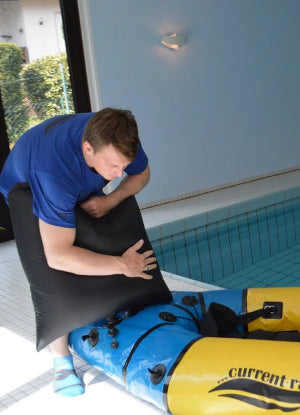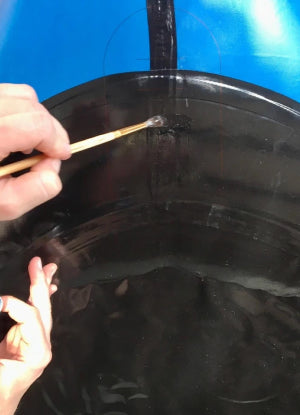Instructions
Care & usage
We recommend using the inflation bag for inflation and applying the residual pressure to the packraft by mouth. This procedure ensures sufficient pressure in the tubes and protects the material. If a pressure pump is used for inflation, we recommend not exceeding a pressure of 0.08 bar or 1.2 PSI.
Correct use / handling
We recommend that you take the following tips into account when handling our TIZIP® zippers:
- Operate the slider carefully. Pulling at an angle can have a negative effect on the tightness of the zippers or affect them in other ways.
- Avoid overstretching the ports and end pieces. Do not pull the two sides of the zipper apart forcefully.
- Take care not to fold or crush the zippers. This can impair the function.
- Close each zipper so that the slider is correctly positioned in the port to guarantee a tight seal.
Lagerung
- TIZIP® zippers should be stored completely closed and without bending.
- The open bearing can cause bends and thus lead to leaks.
- Make sure that the zipper is always stowed away dry and clean.
- Avoid high humidity and temperatures.
- If possible, work according to the FIFO principle in order to use the zippers purchased first.
Cleaning
- We recommend cleaning all our TIZIP® zippers with soapy water and a fine brush.
- Do not use solvents or aggressive cleaning agents, as these can negatively affect the function of the zipper.
- Dirt particles, especially between the teeth, can affect the sealing lip and thus impair the seal.
- If your TIZIP® is used to protect life or material, the user is obliged to check the sealing function before use.
Care
- If lubrication with sliding grease is necessary, please use the original from TIZIP® (lubrication instructions enclosed).
- Please clean the zipper in advance and correct lubrication before use of all TIZIP® types is crucial for the proper functioning of the zippers. SuperSeal zippers must be lubricated along the coupling links and the sealing lip.
- After lubricating, open and close the closure at least five times along its entire length.
- Correct lubrication before use is crucial for the proper functioning of the zipper!
When inflated, our packrafts can be carried comfortably by the installed handles. It is also possible to hold or carry the packraft by the thigh straps and fastening loops. Please do not carry the packraft by the spraydeck or the coaming or pull on it with a heavy load.
Packrafts should always be stored in a dry and dust-free environment. The latter is particularly important when using a TZIP storage system.
A dry, well-ventilated room without direct sunlight is best for storage. Leave your inflated Packrafts to dry well after you return home from your paddling trip. Pay particular attention to moisture between the edges. The packraft can be rolled or folded very small without causing any damage. The coaming can also be double-wrapped and tucked together without any problems.
The Packrafts can be used in salt water or chlorinated pools without restriction. Before storing them, however, you should make sure to thoroughly rinse off any salt or chlorine residue.
The main components of a packraft are the tubes, the floor and optionally the spray deck. These are sewn and thermo-welded together after production. However, they must be fixed with tape before welding. The tape used for this remains on the packraft and cannot be removed after welding. This tape is still visible at the transitions and may give the impression that the spraydeck or the floor is detaching from the packraft.
However, there is no need to worry here, as only the remains of the fixing tape will come off over time. The spraydeck and floor are firmly welded to the tubes and are extremely resilient. We are not aware of any cases of detachment.
In any case, getting out of the packraft should be practiced thoroughly on dry land. The red pull handle for getting out is also easy to recognize underwater. When putting on the spray skirt, make sure that it is always completely outside and freely accessible.
1. Non-swimmers do not belong in a packraft. Anyone who takes non-swimmers out on the water carries a high risk.
2. Avoid paddling alone if possible. Always leave where and until when you plan to travel.
3. Take water sports and safety courses with certified instructors.
4. Find out about the dangers of the water - water levels, tides, currents, weirs and weather conditions. We strongly advise against paddling during floods
5. Avoid weirs, power stations and dams of all kinds. There is often a danger to life here, so it is recommended to portage them.
6. Take first aid and rescue equipment with you on the water.
7. Wear clothing appropriate for the weather. Cold weather and water can cause hypothermia.
8. Assess your ability correctly and plan tours based on the weakest group member.
9. Keep your distance from other watercraft, especially all motor vessels and sailing vessels. Packrafts almost always have to give way and are difficult to see by the skipper.
10. Observe the inland waterway and maritime regulations. They apply to all shipping lanes and canals and contain binding rules for all watercraft.
11. Put on a life jacket or, on large bodies of water, a fainting-proof life jacket and head protection. Wear a cold-weather suit and helmet when whitewater rafting.
12. Particular dangers exist on white water and on the coast. These waters can only be navigated with special equipment and by experienced paddlers, ideally with expert guidance and local knowledge.
13. The emergency exit from the packraft should be practiced. We recommend practicing quick exits on land, in the pool or under supervision.
14. Additional modifications to the packraft must not impair getting in and out.
15. A wet re-entry on the water should be safely mastered before navigating open waters, as well as white water.























